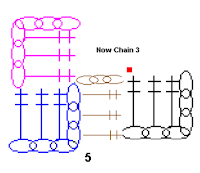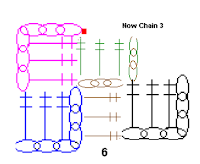I am not sure if this is fact or myth that just after birth, a baby sees only in black and white, with shades of grey. As the months go by, they will slowly start to develop their color vision at around 4 months. What has been proven is that they don't actually differentiate colors at birth and that bright colors, rather than pastels, help in their color differentiation ability.
This beautiful black and white C-2-C blanket is a joy to the eyes - adult and child and I loved the clear cut defined look of it - as does my client. What do you think?
Today I’ve used some Ganga Desire acrylic yarn (in black & white) with a 4.5 mm crochet hook. This yarn is not specific for this project. You can use any yarn with a suitable hook to make this creation.
Thank you for joining me.
In case you have just joined me, know that you can access all of my earlier creations by checking under ‘categories’ on the right hand side of this blog under “Labels”. Then, for your convenience, follow me here or on Facebook, You Tube, Pinterest, Twitter or Instagram.
Oh, and may I add that the fastest way to find any of my blogs is via Pinterest and for more blankets come here
All my blogs can be printed. Find the printer friendly (green) link on the right hand side & bottom of this blog. You can also hit Control P (or Command P for Mac) on your keyboard, and the blog will go directly to the connected printer.
Remember that you only print if absolutely essential. Save paper – Save Our Earth.
Do remember to add my blog URL when you make and show off your creation.
Just copy the link on the search bar above - that's the blog URL.
To purchase this or similar yarn online, click here to buy your yarns online via Amazon. While you will still pay the same, I may get paid by Amazon as well.
This is a free blog - so do pay it forward for me. Cheers.
Come along then and let’s work on this beautiful creation together.
This yarn is not specific for this project.
You can use any yarn with a suitable hook to make this project to any size.
International yarns : Among the international yarns I have used, I’d suggest Aunt Lydia Cotton 10, Aunt Lydia Bamboo-Viscose 10, DMC Petra, Sullivans knitting cotton (Australia), Milford Soft, Hilaza Rustica Eclat , Alize cotton yarn and Alize bamboo yarn.
Size made : 40" x 42”
This is only given to you to get a general idea of how much yarn you may need.
You can make this to any size to just use up your yarn.
Difficulty level : Intermediate Skill level.
Stitches used :
Abbreviations used : (Using U.S terminology)
lp(s) : Loop(s) sc : Single crochet
dc : Double crochet sp : Space
sl-st : Slip stitch ch : Chain
st(s) : Stitch(es) hk : Hook
yo : Yarn Over
Instructions : (Using U.S terminology)
Please note that I start all my rows with a ch 1, turning chain for ease.
Please check the top of this blog for easy video tutorials on all stitches used in today's pattern.
Please read through all my notes before you pick up your hook, so you know just where we're heading in our pattern.
In my patterns I work with the principle of stitch count and body measurement.
This means that you need to work the stitch count in pattern, till you get the measurement (length and/or width) that you need for your project.
With all my patterns you need to think a little bit - and today its a little bit more, especially if this is your first C-2-C creation.
Double Crochet : dc : yo, insert hk into st ; yo (3 lps on hk); [yo, draw through 2 lps] twice. One dc made. Check out the video at https://youtu.be/xdnjB27zpYo Chainless start for Double Crochet : I dislike the ch-2 / ch – 3 start, and this is what I do to start my row of dc.
We’re working the C-2-C pattern with our blanket.
What is C-2-C ? It’s just a pattern that goes from Corner to Corner using four stitches that make a little box-like pattern.
In our pattern today, as you are continually work from side to side in a diagonal, it looks like you have worked a basket stitch in the diagonal – and though it is pretty easy, the end result looks complicatedly fantastic!
So first let's take a look at how to work a C-2-C.
We will work this C-2-C pattern in alternating colors and as long strips.
Each of my strips is 42" long and 5" wide
We will then attach each strip, once again alternating colors, to give this beautiful chevron effect.
You could decide to match black with black (& white with white) each row - and if you do this, then each and every row will start and end in the same way (color wise and pattern wise)
First let's understand how a C-2-C is worked
With the pattern, you start the pattern from the left bottom corner (in our case, for each strip)
The idea is that you will be working from the left hand side of your project to the top right hand side of your project (again in each color and for each strip).
With each row, you will work from side to side along the diagonal, increasing blocks with every row.
As you increase with every row, you will be increasing both the length and breadth/width of your project – all the way till you reach the breadth (which is the right hand side bottom corner of your project).
At this point, you will stop increases, and start decreasing – and this end will then become a straight end.
Now here's where the fun begins.
1) Each strip starts and ends with a triangle.
2) In the centre of each strip you have parallelograms.
3) Start working on your first triangle in Color 1; Change to Color 2 and work a parallelogram ; Change back to Color 1 and work the next parallelogram ; continue changing colors till you have the length you need and end with a triangle.
4) It does NOT matter which color you end with but if you want to interchange colors, you will start with black in Strip 1 and white in Strip 2 (so all odd strips will be black and all even strips will be white)
5) If you decide to have all rows starting and ending with the same color, you will have a different end result (from mine) BUT it will just as pretty
6) Instead of just black and white, you can add in any color and make this a nice multi-colored stash busting project as well.
7) Imagine that each square below is one part of the strip - so you start on the grey portion of the strip and work till you reach the right hand side corner (which is the width of each strip) You then start working the straight edge on that side,
increasing the length of the strip. Got it?
I used grey instead of white, for obvious reasons
The diagrams below are for instruction only and not to scale.
It does not matter how wide your strip is - just decide the width of your blanket, then measure your strip and divide to get the width.
What does this mean?
So say you want to make a 40" blanket (width), then each strip needs to be divisible by 40 - which means that each strip needs to be either 4" or 5" wide.
SO if each strip is 4" wide, you will make a total of 10 strips and if 5" wide, then you will need 8 strips. Got it?
You will continue working parallelograms in alternating color till you reach the top end of your strip. At that point you will work the finishing triangle, which will be the opposite of your start triangle.
As mentioned before, it does not matter which color you end with - just ensure you get the length you need for each strip. Unlike the confusing (?) calculations for width, this is straight forward
Now what is confusing is how many rows you work of each C-2-C pattern.
You work as many little blocks as you need to get the width first.
You will then work the same number of rows upwards to finish each little triangle or parallelogram.
So if you use 7 blocks across for the width (as I have), then you will work 7 blocks upwards in a diagonal each and every time.
You will then count off 2 blocks along the bottom and 7 blocks along the side for the 1st triangle - then change to color 2.
In each following parallelogram, you will count off 7 blocks along both the sides & then change color
In your final block, you will count along the top edge and side to ensure you have 7 blocks to finish.
Depending on which color you start each strip, you will get a different end result
Start with the alternate color every strip for this result (which is what I've done)
Start with the same color every strip for this result
and here's a photo tutorial for the C-2-C stitch pattern as well
Finishing ideas :
I find that joining is one of the most tedious jobs - as we need to weave in ends among other things. So rather than put off for the end, I preferred to join the strips as I went along. No only did I find this less tedious, but it also gives you an idea of the width - and of course it's always fun to see your blanket grow.
Have fun and do remember to share my blog post when you show off your creation.
If you're visiting me here for the first time, and have liked the experience, do add me to your mailing list (for your convenience) , and all my future free patterns will come straight to your mail box.
It is sad that though my blogs are very popular and being used by so many, not many think of giving credit when you post your projects on social media.
There is a lot of work that goes into writing one of these patterns, so do pay it forward – good karma and all that blah
If you're visiting me here for the first time, and have liked the experience, do add me to your mailing list (for your convenience) , and all my future free patterns will come straight to your mail box.
I’d appreciate if you could credit my blog (and link the original pattern link) when you make your own creation. Thanks.
Have a great day and see you soon.
Here are some of my older blanket / granny square creations. Have fun with these free patterns too
Here are some of my tops for your perusal
and a doll’s top..
and some bolero/jacket/vests that will look grand on a top..
I have a few girls dresses, and just in case you want a dekho at those free patterns … here you go
For cute hair embellishments and motifs check the links below.
..and some belts..
and here are a few skirt patterns that you can use your belt for..



















No comments:
Post a Comment
Thanks for taking the time to stop by. Do tell me what you think. Cheers